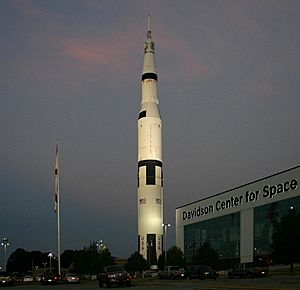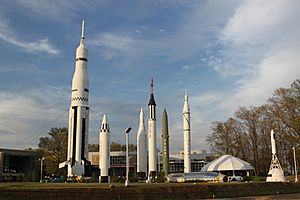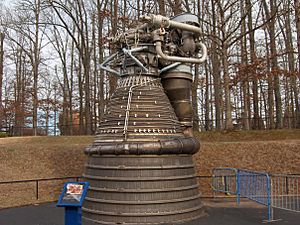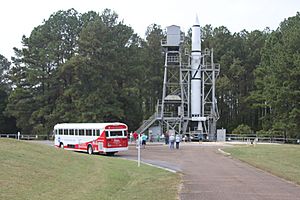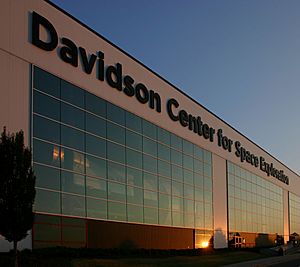- This page was last modified on 17 October 2025, at 10:18. Suggest an edit.
U.S. Space & Rocket Center facts for kids
 |
|
| Established | 1965 |
|---|---|
| Location | Huntsville, Alabama |
| Type | Science museum |
| Owner | State of Alabama |
| Association of Science-Technology Centers | |
|
|
The U.S. Space & Rocket Center in Huntsville, Alabama is a super cool museum! It's run by the state of Alabama and shows off amazing rockets, space achievements, and items from the U.S. space program. Some people even call it "Earth's largest space museum." Astronaut Owen Garriott once said it's "a great way to learn about space."
The center first opened in 1970, right after the Apollo 12 mission, which was the second time humans landed on the Moon. Here, you can see real Apollo Program equipment, like the Apollo 16 capsule. There are also fun, hands-on science exhibits, Space Shuttle displays, and even Army rockets and aircraft. The museum has over 1,500 space artifacts and often hosts new exhibits. It's located next to the Huntsville Botanical Garden. You can even take bus tours to nearby NASA's Marshall Space Flight Center.
The center also has two awesome camp programs where visitors can stay and learn about spaceflight and aviation. U.S. Space Camp lets you dive deep into the space program. You get to use simulators, listen to talks, and do training exercises. Aviation Challenge gives you a taste of military fighter pilot training, with simulations, lessons, and even survival exercises. Both camps offer programs for kids and adults, whether you want to stay overnight or just visit for the day.
Contents
Exploring Space: Exhibits at the Center
The U.S. Space & Rocket Center has one of the biggest collections of space artifacts anywhere, with more than 1,500 items on display. You can see rockets, engines, spacecraft, simulators, and lots of hands-on exhibits.
The Space & Rocket Center shows you the history of U.S. rockets. You can see early German rockets like the V-1 flying bomb and V-2 rocket. Then, you'll see U.S. military rockets like the Redstone and Jupiter. There are also civilian rockets like the Mercury-Redstone and the Juno II. You can even see the huge Saturn rockets, including a tall Saturn I rocket that stands upright and is a famous landmark. The Saturn V Dynamic Test Vehicle, a massive rocket, is displayed inside a special building called the Davidson Center for Space Exploration. There's also a Space Shuttle mockup called Pathfinder that was put back on its external tank and boosters in September 2024.
The museum also has important military rockets. These include rockets from the Project Nike series, which were the first missile defense system. You can also see the MIM-23 Hawk missile, the MGR-1 Honest John, and the MIM-104 Patriot missile, which was used in the 1991 Gulf War.
The rocket collection also includes many engines. Besides the engines on the rockets, you can see separate engines. These include two F-1s, which are giant engines that produced 1.5 million pounds of thrust to launch the Saturn V rockets. There's also the J-2 engine, which powered the second and third stages of the Saturn V. You can even see engines from the Lunar Module that landed on the Moon.
The Apollo program has a big section in the Davidson Center for Space Exploration. You can see items from the Apollo missions. Astronauts walked across a red walkway to the White Room, both on display, to get into the Command Module. This was their "cabin" for the trip to the Moon and back. The Apollo 16 command module, which orbited the Moon 64 times in 1972, is on display. The Saturn V Instrument Unit controlled the powerful F-1 engines as the rocket launched. You can also see a mockup of the Lunar Module that took astronauts to the Moon's surface. There, they collected Moon rocks, like the Apollo 12 Lunar Sample Number 12065,15, which is at the museum. Later Moon trips used a Lunar Roving Vehicle, which is displayed next to the Lunar Module.
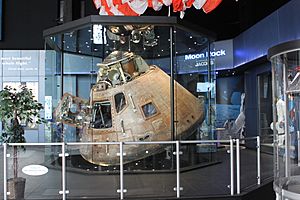
The Apollo 16 capsule, which orbited the Moon 64 times in 1972, is displayed with its recovery parachute.
A restored model of Skylab, an early space station, is also on display. This shows what happened after the Apollo Moon missions. Many simulators help visitors understand what spaceflight feels like. The Space Shot ride makes you feel 4 times the force of gravity (like a launch!) and then a few seconds of weightlessness. The G-Force Accelerator gives you 3 times the force of gravity for a longer time using a spinning machine. There are other fun simulators too!
Other exhibits let you get hands-on with ideas about rockets and space travel. A bell jar shows why rockets work in the vacuum of space, where propellers don't. A wind tunnel lets you move a model to see how air forces change. The Mind of Saturn exhibit shows how gyroscopic force helps rockets navigate. You can even climb into an Apollo trainer!
Some simulators on display were actually used to train astronauts. A Project Mercury simulator shows how cramped the first Americans in space were. A Gemini simulator shows how two people flew together for the first U.S. missions that included spacewalks and meeting up with other spacecraft in orbit.
Exhibits also look at the future of space flight. You can see models of the Orion spacecraft, which is NASA's next crew vehicle. There's also a Bigelow Aerospace commercial habitat model, showing ideas for space tourism.
Bus Tours and Traveling Exhibits
The Space & Rocket Center used to offer bus tours of Marshall Space Flight Center. These tours showed visitors important places like the Redstone Test Stand, where Alan Shepard's rocket was tested. They also visited the Payload Operations and Integration Center, which controls many experiments. These tours stopped after the September 11 attacks in 2001 but started again in 2012. As of 2023, tours of Marshall Space Flight Center are no longer offered. However, bus tours of Space Camp's Aviation Challenge are still available.
The Space and Rocket Center also hosts special traveling exhibits. In 2010, they had "Star Wars: Where Science Meets Imagination." They've also hosted exhibits like "The Chronicles of Narnia: The Exhibition" and "Mammoths and Mastodons: Titans of the Ice Age."
Miss Baker's Resting Place
The U.S. Space & Rocket Center is the final resting place of Miss Baker. She was a squirrel monkey who flew on a test flight of the PGM-19 Jupiter rocket in 1959. Miss Baker lived at the center from 1971 until she passed away in 1984.
History of the Center
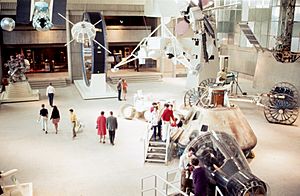
Visitors to the new museum saw Mercury and Apollo 6 capsules, lunar rovers, and more.
The idea for this museum came from Dr. Wernher von Braun. He was a key leader in the U.S. effort to land the first person on the Moon. Plans for the museum started in 1960.
To help get the museum built, Von Braun even convinced famous football coaches Bear Bryant and Shug Jordan to appear in a TV commercial! They supported a statewide vote to get money for the museum. The vote passed in 1965, and the Army donated land from Redstone Arsenal for the location.
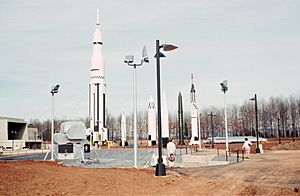
On display immediately were the lunar landscape with lunar lander mockup, and a wide variety of hardware from United States Army Aviation and Missile Command, NASA, and aerospace companies, including a helicopter, and the rocket park.
To attract many visitors, the center needed something truly special. The director, Edward O. Buckbee, worked with von Braun to bring the Saturn V Dynamic Test Vehicle to the site. This huge rocket arrived on June 28, 1969. The Saturn I rocket, which stands upright at the museum, arrived the same day. The center officially opened on March 17, 1970.
The Space & Rocket Center was a big supporter of the U.S. pavilion at the 1982 World's Fair. They provided space and energy exhibits and ran the IMAX theater there. The Spacedome IMAX theater at the museum opened in December 1982. It was later updated in 2019 to become the Intuitive Planetarium, with amazing high-definition digital projectors.
In 2000, Larry Capps became the museum's director. He helped reduce the museum's debt and oversaw the building of the Davidson Center for Space Exploration. This new building was designed specifically to house the Saturn V Dynamic Test Vehicle. Capps retired in 2010.
Dr. Deborah Barnhart, who had led Space Camp before, took over as director in 2010. She brought new training equipment for the Orion spacecraft to Space Camp. She retired in December 2019.
In July 2020, the center asked for donations because it had lost a lot of money due to the COVID-19 pandemic. The community responded quickly, and the center raised enough money to keep operating.
On December 15, 2020, Dr. Kimberly Robinson was announced as the new director, starting in February 2021.
Buildings at the Center
Huntsville architect David Crowe designed the first museum building, which had 22,000 square feet (2,000 square meters) of exhibit space. Since 1969, people in Huntsville could see the tall, vertical Saturn I rocket at the U.S. Space & Rocket Center from far away. In 1999, a full-size model of the Saturn V rocket was put up, standing almost twice as tall as the Saturn I.
The dome theater opened in December 1982 and was updated in early 2019 to become the INTUITIVE Planetarium.
The 1986 movie SpaceCamp helped make the camp very popular. The number of campers more than doubled, so the facilities had to be made bigger.
A new NASA Educator Resource Center was built and opened in mid-2005.
The newest building at the U.S. Space & Rocket Center is the Davidson Center for Space Exploration. It's named after Dr. Julian Davidson. This 68,000-square-foot (6,300-square-meter) building opened in January 2008. The Davidson Center was built to hold the Saturn V Dynamic Test Vehicle and many other space exploration exhibits. The rocket is lifted above the floor, and its different parts and engines are visible, so visitors can walk underneath it. The Davidson Center also has a 3D movie theater, in addition to the planetarium in the original museum.
How the Center is Managed
The U.S. Space & Rocket Center is owned by the State of Alabama. It's run by the Alabama Space Science Exhibit Commission (ASSEC). This group has 18 members chosen by the Governor. The ASSEC meetings are open to the public.
The U.S. Space & Rocket Center Foundation is a non-profit group that helps raise money for the ASSEC.
Visitors to the Center
The Space & Rocket Center is a very popular place! In 2010, over 540,000 people visited. In 2013, more than 584,000 people came, making it the top paid-tourist attraction in Alabama. By 2017, over 786,000 people visited, making it number one among state attractions that charge admission.
The NASA Human Exploration Rover Challenge, also known as the Great Moonbuggy Race, has happened every year since 1994. Most of these races have been held at the Space & Rocket Center. In this challenge, high school and college students design and build a small moonbuggy. They then assemble it at the site and drive it across a pretend lunar landscape.

